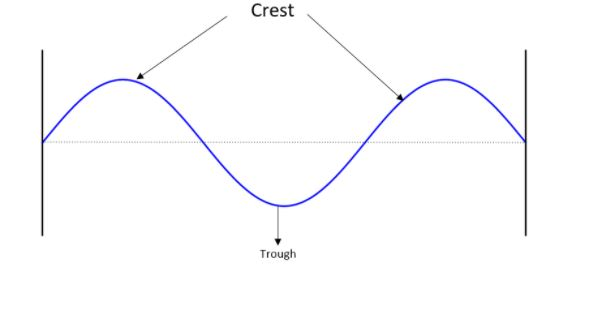
Describe the terms crest and trough in relation to a transverse wave.
Answer
555k+ views
Hint: If the crests and troughs of two sine waves which are having similar amplitude as well as frequency will get intersected or collided. When they are in phase with each other, the resultant of this wave will be known as constructive interference. In the case of an antiphase which can be otherwise called as the out of phase condition where the phase angle will be $180{}^\circ $. This will result in the destructive interference to take place.
Complete step by step solution:
A crest is found to be a position on a wave which will be the maximum value of the upward displacement within a cycle. A crest will be a point on the surface wave where the displacement of the medium will be at a maximum. A trough can be defined as just the opposite of a crest. That means the trough will be the minimum or the lowest point in a cycle. If the crests and troughs of two sine waves which are having similar amplitude as well as frequency will get intersected or collided. When they are in phase with each other, the resultant of this wave will be known as constructive interference. We can say that the magnitudes will be doubled (above and below the line). If in the case of an antiphase which can be otherwise called as the out of phase condition where the phase angle will be $180{}^\circ $. This will result in the destructive interference to take place. Here the net wave will be the undisturbed line which is having a zero amplitude. Therefore the crest and trough of a transverse wave has been explained. The answer for the question has been obtained.

Note: A transverse wave can be defined as a wave in motion whose oscillations are orthogonal to the direction of the wave or the path of propagation. A rope whose one end has been tied to a rigid support and the other end made to move will be given as a transverse wave. This is one of the examples for the transverse wave.
Complete step by step solution:
A crest is found to be a position on a wave which will be the maximum value of the upward displacement within a cycle. A crest will be a point on the surface wave where the displacement of the medium will be at a maximum. A trough can be defined as just the opposite of a crest. That means the trough will be the minimum or the lowest point in a cycle. If the crests and troughs of two sine waves which are having similar amplitude as well as frequency will get intersected or collided. When they are in phase with each other, the resultant of this wave will be known as constructive interference. We can say that the magnitudes will be doubled (above and below the line). If in the case of an antiphase which can be otherwise called as the out of phase condition where the phase angle will be $180{}^\circ $. This will result in the destructive interference to take place. Here the net wave will be the undisturbed line which is having a zero amplitude. Therefore the crest and trough of a transverse wave has been explained. The answer for the question has been obtained.

Note: A transverse wave can be defined as a wave in motion whose oscillations are orthogonal to the direction of the wave or the path of propagation. A rope whose one end has been tied to a rigid support and the other end made to move will be given as a transverse wave. This is one of the examples for the transverse wave.
Recently Updated Pages
Master Class 12 Business Studies: Engaging Questions & Answers for Success

Master Class 12 Economics: Engaging Questions & Answers for Success

Master Class 12 English: Engaging Questions & Answers for Success

Master Class 12 Maths: Engaging Questions & Answers for Success

Master Class 12 Social Science: Engaging Questions & Answers for Success

Master Class 12 Chemistry: Engaging Questions & Answers for Success

Trending doubts
What are the major means of transport Explain each class 12 social science CBSE

Which are the Top 10 Largest Countries of the World?

Draw a labelled sketch of the human eye class 12 physics CBSE

How much time does it take to bleed after eating p class 12 biology CBSE

Explain sex determination in humans with line diag class 12 biology CBSE

Differentiate between homogeneous and heterogeneous class 12 chemistry CBSE




